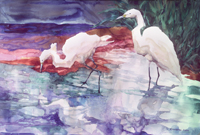Buckminster Fuller (1895-1983) was an artist whose work dealt with the myriad, quotidian problems of average people, but to understand his artwork the curators of the current retrospective of his work at the Whitney Museum, thankfully, have given us a glossary of key terms (and diagrams) to help us interpret the complicated answers to the large questions the artist addressed. In simple terms, they describe Fuller’s artistic motivation as “what an individual might do to help humanity,” with visual answers spanning such fields as architecture, the visual arts, literature, mathematics, and engineering.
Though he could be considered more of a conceptual thinker, a scientist, a mathematician, a scholar and a problem-solver than what we might normally think of as an artist, Buckminster Fuller was in fact all of these things, and his ability to translate these thoughts into physical form classified him as an artist. His works of art do not take traditional forms; to use traditional methods of categorizing art projects, his “drawings” in graphite on aging paper are plans for projects, his “sculptures” are cardboard, metal and multimedia models for constructions and the occasional finished structure, and his other work could be called “installation artwork.” The difficulty art historians may have in assigning names or descriptive terms to his projects, however, was not a problem for their creator. Fuller named his projects with complicated specificity using his own terms, such as “Geodesic Dome” or “Dymaxion Car” or “Dymaxion Air-Ocean World Map.”
Fuller’s projects, ranging from energy efficient cars, housing models (such as his 1945 Dymaxion Dwelling Machine), hospital designs and other solutions to problems of living and environmental use, held at their core his belief that we need better solutions to how we use and impact our environment and how we should more efficiently allocate its resources. His dome-like structure for the US Pavillion of the 1967 Expo in Montreal, for example, was a structure which required no internal supports yet was a stable and useful structure. It was built using the fewest possible materials to enclose the largest possible internal space. His Dymaxion Air-Ocean World Map, a map of the world cut into triangles and rectangles and reassembled to create a single landmass, addresses the issue of the humanity’s commonality and interconnectedness and questions the distribution of resources (the way in which we do it versus how it might otherwise be accomplished.) Fuller’s intuitive interest in sustainability and desire for us to live with the smallest possible footprint upon the earth translated into a man far ahead of his time. Or maybe we are all way behind ours…
Buckminster Fuller: Starting with the Universe runs through September 21 at the Whitney Museum of American Art, 945 Madison Avenue, New York City. The glossary is on the Whitney’s website.


